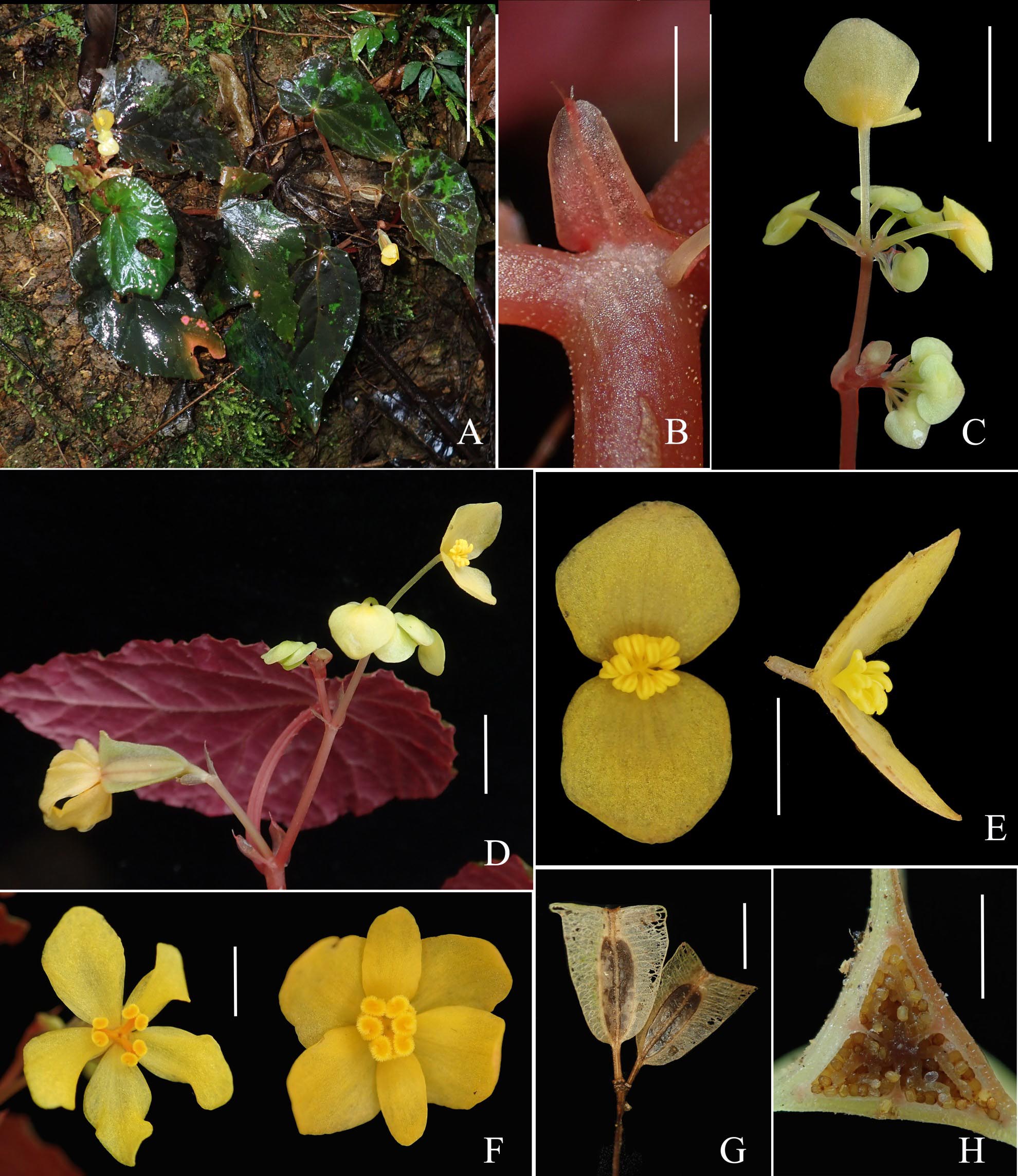Begonia tjiasmantoi in Reinwardtia 19(1): 61. 2020
Primary tabs

Diagnosis
- Begonia tjiasmantoi has a rhizomatous stem, male and female flowers with yellow tepals and male flowers with relatively few stamens (22‒24). This character combination differentiates it from other Sulawesi Begonia species. The rhizomatous growth habit of Begonia tjiasmantoi is similar to the growth habit of the orange-tepalled B. ignita C.W.Lin & C.I.Peng, but B. tjiasmantoi can be differentiated by its strongly asymmetric, ovate to elliptic leaves (8–11 × 3.5–5.5 cm); cymose-paniculate male inflorescence with subumbellate partial inflorescences with up to 6 flowers; yellow male flower tepals that are relatively small (6–8 × 7.5–8.5 mm) and have few stamens (22–24); female flowers with shorter pedicels (3–4 mm), 5(–6) yellow tepals, and a cylindrical seed-bearing part of the fruit. Begonia ignita has symmetric or subsymmetric cordiform leaves that are larger (7–12 × 6.5–11 cm); racemose-cymose male inflorescence with monochasial partial inflorescences with up to 3 flowers; orange male flower tepals that are larger in size (10–15 × 9–11 mm), more stamens (35–45); female flowers with longer pedicels (6–13 mm), 4 (or rarely 2, 3 or 5) orange tepals, and an ellipsoid seed-bearing part of the fruit. (Ardi, W.H. & Thomas, D.C. 2020: Begonia tjiasmantoi, a new species from West Sulawesi. – Reinwardtia 19(1): 61-65. http://doi.org/10.14203/reinwardtia.v19i1.3848)
Description
- Perennial, monoecious herb, up to ca. 15 cm tall. Stem rhizomatous, few-branched, internodes 0.5–2.5 cm long, reddish, glabrous except for microscopic glandular hairs. Leaves alternate; stipules persistent, elliptic, 6–12 × 3–8 mm, reddish, glabrous, midrib prominent, margin entire, translucent, apex narrowed into bristle up to 1 mm long; petioles 4–10 mm long, reddish-brownish, terete, shallowly channeled, glabrescent; lamina basifixed, ovate to elliptic, 8–11 × 3.5–5.5 cm, very asymmetric, base cordate, lobes sometimes slightly overlapping, apex acuminate, margin dentate, adaxially dark brown-reddish with irregular variegation of greenish blotches, glabrous, abaxial surface crimson red with greenish blotches, hairy on the veins only; venation palmate-pinnate, with 5–6 primary veins, actinodromous, secondary veins craspedodromous, primary and secondary veins slightly prominent on the adaxial surface. Inflorescences protogynous; solitary female flower or 2-flowered female partial inflorescence one node basal to male inflorescence part, peduncle 8−15 mm long, reddish, glabrous, bracts stipule-like, elliptic, ca. 8 × 3 mm, margin entire, apex bristle up to 1 mm long, reddish, translucent, glabrous, persistent; male inflorescence part paniculate-cymose, composed of up to 3 sub-umbellate partial inflorescences, each with up to 6 flowers, peduncle of partial inflorescence up to 11.5 mm long, glabrous; bracts stipule-like, persistent, ovate, ca. 6.5 × 3.5 mm, translucent, midrib slightly prominent, reddish, glabrous, apex acuminate and narrowed into bristle ca. 1 mm long. Male flowers: pedicels 10–15 mm long, yellowish-greenish, hairy; tepals 2, yellow, broadly ovate to suborbicular, 6–8 × 7.5–8.5 mm, abaxial surface glabrous, margin entire, apex rounded; androecium yellow, stamens 22–24, free filaments up to ca.1.3 mm long, fused at the base, anthers 0.5–0.8 mm long, dehiscing through unilaterally positioned slits ca. ½ as long as the anthers. Female flowers: pedicel 3–4 mm long, yellowish, glabrous; tepals 5(–6), yellow, subequal to unequal, ovate to elliptic, 6–12 × 2–8 mm, abaxially glabrous, margin entire, apex rounded; ovary cylindrical, 6–12 × 2–4 mm (excluding the wings), yellowish-green, glabrous, locules 3, placentae bilamellate, wings 3, equal to subequal, base rounded to cuneate, apex truncate or subtruncate, widest point up to 6 mm (apically); style up to 3 mm long, basally fused, 3-branched, each stylodium bifurcate in the stigmatic region, stigmatic surface a spirally twisted papillose band, orange. Fruits: peduncles up to 20 mm long; pedicels 4–5 mm long, not recurved; seed-bearing part cylindrical, 8–14.5 × 3.5–4.5 mm (excluding the wings), wing shape as for ovary, widest point up to ca. 7 mm. Seeds barrel-shaped, 0.2–0.3 mm long. (Ardi, W.H. & Thomas, D.C. 2020: Begonia tjiasmantoi, a new species from West Sulawesi. – Reinwardtia 19(1): 61-65. http://doi.org/10.14203/reinwardtia.v19i1.3848)
Habitat
- Strongly disturbed secondary forest, growing terrestrially on steep slopes of an irrigation water channel in a coffee plantation, in dense shade, at 900–1,100 m asl. (Ardi, W.H. & Thomas, D.C. 2020: Begonia tjiasmantoi, a new species from West Sulawesi. – Reinwardtia 19(1): 61-65. http://doi.org/10.14203/reinwardtia.v19i1.3848)
Conservation
- Critically Endangered (CR) B1ab(iii), B2ab(iii). Begonia tjiasmantoi is known from only a single collection and a few additional observed individuals at the type locality. The location is not legally protected and on land that is part of a coffee plantation. Anthropogenic threats through agriculture including herbicide use, and associated habitat deterioration and loss were observed. Previous exploration in the Quarles Mountains has not resulted in any other collections of this species, so we must assume, at least until additional collection efforts reveal otherwise, that it has a very restricted distribution. Because of the single known location and associated very small extent of occurrence (EOO) and area of occupancy (AOO), the limited number of observed mature individuals, and the observed anthropogenic threats, we assess this species as Critically Endangered. (Ardi, W.H. & Thomas, D.C. 2020: Begonia tjiasmantoi, a new species from West Sulawesi. – Reinwardtia 19(1): 61-65. http://doi.org/10.14203/reinwardtia.v19i1.3848)
Notes
- Begonia tjiasmantoi is a very distinct species on account of its rhizomatous stem and yellow-tepalled flowers. Sulawesi Begonia species in section Petermannia have mainly usually white, pinkish or sometimes greenish tepals, but there are exceptions including species that have orange (Begonia ignita) and coral-pink (B. stevei) tepal coloration. (Ardi, W.H. & Thomas, D.C. 2020: Begonia tjiasmantoi, a new species from West Sulawesi. – Reinwardtia 19(1): 61-65. http://doi.org/10.14203/reinwardtia.v19i1.3848)

